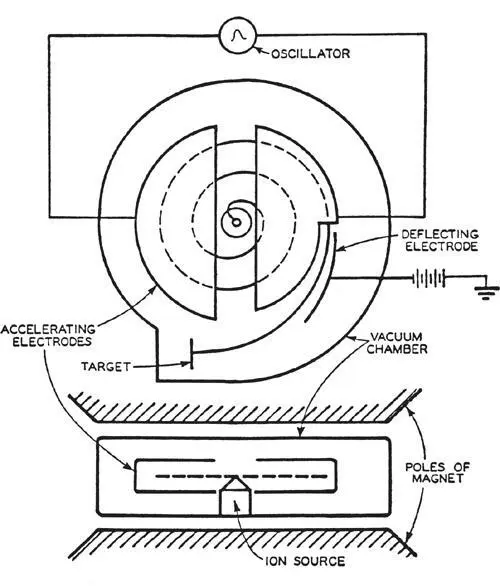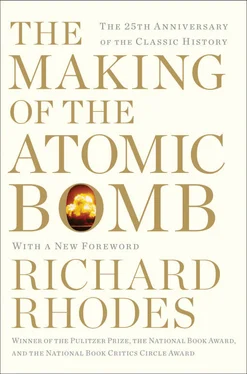Exuberantly Lawrence ran off to tell the world. An astronomer who was still awake at the faculty club was drafted to check his mathematics. He shocked one of his graduate students the next day by bombarding him with the mathematics of spiral accelerations but mustering no interest whatever in his thesis experiment. “Oh, that,” Lawrence told the questioning student. “Well, you know as much on that now as I do. Just go ahead on your own.” 540A faculty wife crossing the campus the next evening heard a startling “I’m going to be famous!” as the young experimentalist burst past her on the walk. 541
Lawrence then traveled East to a meeting of the American Physical Society and discovered that not many of his colleagues agreed. To less inspired mechanicians the scattering problem looked insurmountable. Merle Tuve was skeptical. Jesse Beams, a Yale colleague and a close friend, thought it was a great idea if it worked. Despite Lawrence’s reputation as a go-getter—perhaps because no one encouraged him, perhaps because the idea was solid and sure in his head but the machine on the laboratory bench might not be—he kept putting off building his spiral particle accelerator. He was not the first man of ambition to find himself stalling on the summit ridge of a famous future.
Oppenheimer arrived in a battered gray Chrysler in the late summer of 1929 from another holiday at the Sangre de Cristos ranch with Frank—the ranch was named Perro Caliente now, “hot dog,” Oppenheimer’s cheer when he had learned the property could be leased. 542He put up at the faculty club and the two opposite numbers, he and Lawrence, became close friends. Oppenheimer saw “unbelievable vitality and love of life” in Lawrence. “Work all day, run off for tennis, and work half the night. His interest was so primarily active [and] instrumental and mine just the opposite.” 543They rode horses together, Lawrence in jodhpurs and using an English saddle in the American West—to distance himself, Oppenheimer thought, from the farm. When Lawrence could get away they went off on long recreational drives in the Reo to Yosemite and Death Valley.
A distinguished experimentalist from the University of Hamburg, Otto Stern, a Breslau Ph.D., forty-one that year and on his way to a Nobel Prize (though Lawrence would beat him), gave Lawrence the necessary boost. Sometime after the Christmas holidays the two men dined out in San Francisco, a pleasant ferry ride across the unbridged bay. Lawrence rehearsed again his practiced story of particles spinning to boundless energies in a confining magnetic field, but instead of coughing politely and changing the subject, as so many other colleagues had done, Stern produced a Germanic duplicate of Lawrence’s original enthusiasm and barked at him to leave the restaurant immediately and go to work. Lawrence waited in decency until morning, cornered one of his graduate students and committed him to the project as soon as he had finished studying for his Ph.D. exam.
The machine that resulted looked, in top and side views, like this:

The two cylinders of the Wideröe accelerator have become two brass electrodes shaped like the cut halves of a cylindrical flask. These are contained completely within a vacuum tank and the vacuum tank is mounted between the round, flat poles of a large electromagnet.
In the space between the two electrodes (which came to be called dees because of their shape), at the center point, a hot filament and an outlet for hydrogen gas work together to produce protons which stream off into the magnetic field. The two dees, alternately charged, push and pull the protons as they come around. When they have been accelerated through about a hundred spirals the particles exit in a beam which can then be directed onto a target. With a 4.5-inch chamber and with less than 1,000 volts on the dees, on January 2, 1931, Lawrence and his student M. Stanley Livingston produced 80,000-volt protons.
The scattering problem solved itself at low accelerations when Livingston thought to remove the fine grid of wires installed in the gap between the dees that kept the accelerating electric field out of the drift space inside. The electric fields between the dee edges suddenly began functioning as lenses, focusing the spiraling particles by deflecting them back toward the middle plane. “The intensity then became a hundred times what it was before,” Livingston says. 544That effect was too weak to confine the higher-speed particles. Livingston turned his attention to magnetic confinement. He suspected the particle beam lost focus at higher speeds because the pole faces of the magnet were not completely true, a lack of uniformity which in turn caused irregularities in the magnetic field. Impulsively he cut sheets of iron foil into small shims “having a shape much like an exclamation point,” as Lawrence and he would write in the Physical Review, and inserted the shims by trial and error between the pole faces and the vacuum chamber. 545Thus tuning the magnetic field “increased the amplification factor… from about 75 to about 300”— Lawrence added these triumphant italics. With both electric and magnetic focusing, in February 1932 an eleven-inch machine produced million-volt protons. It had a nickname by then that Lawrence would make official in 1936: cyclotron. Even in the formal scientific report to the Physical Review on April 1, 1932, he was unable to contain his enthusiasm for the new machine’s possibilities:
Assuming then a voltage amplification of 500, the production of 25,000,000 volt-protons [!] would require 50,000 volts at a wave-length of 14 meters applied across the accelerators; thus, 25,000 volts on each accelerator with respect to ground. It does appear entirely feasible to do this. 546
The magnet for that one would weigh eighty tons, heavier than any machine used in physics up to that time. Lawrence, now a full professor, was already raising funds.
* * *
In his graduate-student days in Europe Robert Oppenheimer told a friend that he dreamed of founding a great school of theoretical physics in the United States—at Berkeley, as it happened, the second desert after New Mexico that he chose to colonize. 547Ernest Lawrence seems to have dreamed of founding a great laboratory. Both men coveted success and, each in his own way, the rewards of success, but they were differently driven.
Oppenheimer’s youthful preciosity matured in Europe and the early Berkeley years into refinement that was usually admirable if still sometimes exquisite. Oppenheimer crafted that persona for himself at least in part from a distaste for vulgarity that probably originated in rebellion against his entrepreneurial father and that was not without elements of anti-Semitic self-hatred. Along the way he convinced himself that ambition and worldly success were vulgar, a conviction bolstered nicely by trust fund earnings to the extent of ten thousand dollars a year. Thereby he confounded his own strivings. The American experimental physicist I. I. Rabi would later question why “men of Oppenheimer’s gifts do not discover everything worth discovering.” 548His answer addresses one possible source of limitation:
It seems to me that in some respects Oppenheimer was overeducated in those fields which lie outside the scientific tradition, such as his interest in religion, in the Hindu religion in particular, which resulted in a feeling for the mystery of the universe that surrounded him almost like a fog. He saw physics clearly, looking toward what had already been done, but at the border he tended to feel that there was much more of the mysterious and novel than there actually was…. Some may call it a lack of faith, but in my opinion it was more a turning away from the hard, crude methods of theoretical physics into a mystical realm of broad intuition.
Читать дальше













